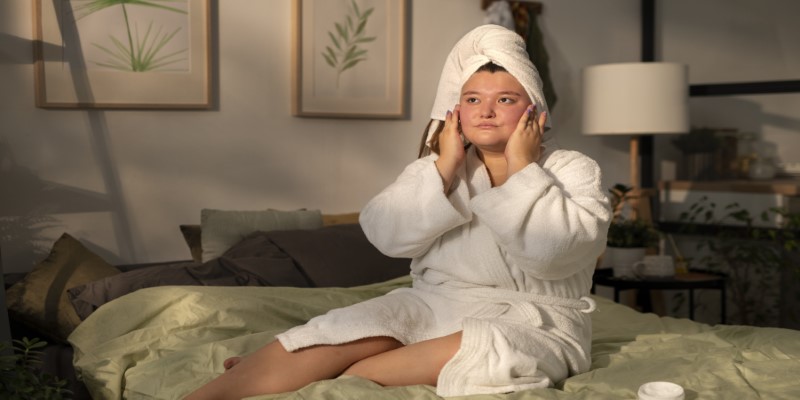Are you fed up with bad hair days? Do you want to keep your hair clean and healthy without washing it? You have reached the right place!
We want our hair care regimens to be as simple as possible because of the hectic pace of modern life. Dry shampoo has become a lifesaver, as it may revive hair without requiring a full wash. Commercial dry shampoos often contain elements that some may find offensive.
A homemade, natural alternative is now available: dry shampoo. This comprehensive article will go into a simple DIY dry shampoo formula and provide specific insights on utilizing it efficiently.

What Is DIY Dry Shampoo?
Dry shampoo cleans and freshens dry hair between washes. It is sprayed or powdered on the scalp and hair roots. Dry shampoo provides the appearance of freshly washed hair without water or shampoo. It collects scalp and hair oil, sweat, and filth.
Starches, clays, and powders are common in dry shampoos because of their absorbing characteristics. To Absorbing excess oil and dirt, these substances help your hair appear cleaner and fuller.

Benefits of DIY Dry Shampoo:
Before the recipe, let's see why DIY dry shampoo is so popular. Dry shampoos contain talc, parabens, and synthetic scents that some individuals are sensitive to. Making your dry shampoo gives you complete control over the composition and contents.
Benefits of DIY Dry Shampoo:
- Natural Ingredients: You can use all-natural components instead of risking exposure to chemicals and allergies in store-bought alternatives.
- Cost-Effective: Making your dry shampoo is often more cost-effective than buying one.
- Customizable: You can customize the formula to achieve your desired hair color and scent.
- Reduced Environmental Impact: The wastefulness of commercial product packing and shipping can be reduced by doing things yourself.
How to Make Your Dry Shampoo:
Here, we will discuss the specifics of making your dry shampoo. Because it calls for everyday ingredients, this dish is simple to put together.
Ingredients:
- Baking Soda: 1 tablespoon
- Adjust the cocoa powder or cinnamon amount to achieve the desired hair shade.
- 5-10 drops of essential oil (lavender, rosemary, or tea tree are all good options) (optional) for aroma.
Instructions:
- Mix the Dry Stuff: Mix cornstarch, arrowroot powder, and baking soda in a bowl. These substances act synergistically to absorb excess oil from your scalp and hair.
- Add Color: For light hair, cocoa powder for dark hair or cinnamon can be added to the routine. The trick is to achieve a tint that smoothly merges with your hair color, ensuring no apparent remnants.
- Fragrance (Optional): Use 5-10 drops of your preferred essential oil to create a fragrant dry shampoo. Lavender, rosemary, and tea tree oil impart wonderful scents and give additional advantages to your scalp.
- Mix Thoroughly: Make sure the dry shampoo ingredients are thoroughly mixed. That is a necessary step for ensuring a consistent coating of the product.
- Store: Put the dry shampoo in a sterile, airtight container. For hassle-free application, reuse an old spice jar or buy a tiny glass jar with a shaker top.
How to Use DIY Dry Shampoo:
Now that you've prepared your dry shampoo, let's investigate the step-by-step procedure of applying it correctly for optimal effects.
Section Your Hair:
Separate your hair into parts before applying the homemade dry shampoo. You can work on one section at a time using hair clips to keep it in place. That is necessary to apply the dry shampoo uniformly.
Apply:
Apply the homemade dry shampoo to your hair's roots using a makeup brush or a clean, unused powder brush. Pay special attention to the crown and section of your hair, among the first spots to become oily.
Massage In:
Apply the dry shampoo with your fingertips on your scalp. In addition to ensuring that the powder is spread uniformly, the massaging motion also stimulates the scalp, which is good for the health of the hair and the scalp.
Wait, Brush:
Give the dry shampoo a few minutes to work and soak up any extra oil. That is an essential step for maximum efficiency. The powders will do their magic during this time by soaking up excess oil and revitalizing your hair.
After waiting, brush your hair vigorously to remove the powder with a boar bristle or wide-toothed comb. This process also aids in dispersing the substance uniformly.
Style as Wanted
You can style it as usual once your hair has been revitalized. In addition to removing excess oil from your hair, the dry shampoo will add volume and texture to your locks.
Can Dry Shampoos Damage Hair and Scalp?
Of course, poisonous dry shampoos can have many adverse effects, but it is not the same for natural or DIY dry shampoos. The dry shampoos made at home are safe. However, frequent dry shampooing can damage hair and scalp. Overuse strips hair and scalp of natural oils, causing overproduction.
Dry shampoo, store-bought or homemade, can clog hair follicles. According to studies, clogged hair follicles can cause thinning, hair loss, and reduced shine and volume. Clogged hair follicles reduce blood flow and hair development. Itchy scalp and dandruff can result from overusing dry shampoo.
Dry shampoo is a practical way to lengthen the time between hair washes, but it cannot replace water-based washing. Overusing dry shampoo without cleansing might cause scalp difficulties or product accumulation. To maintain scalp and hair healthy, use dry shampoo sparingly and wash your hair with water and regular shampoo.
Conclusion:
You now know how to make your dry shampoo at home, apply it correctly, and get the best possible results. Say bye to oily hair days and hello to a natural, adaptable method of maintaining clean, healthy locks. DIY dry shampoo is appealing because it is cheap and easy to make and allows you to tailor your hair care regimen to your beliefs and tastes by using whatever ingredients you like.







